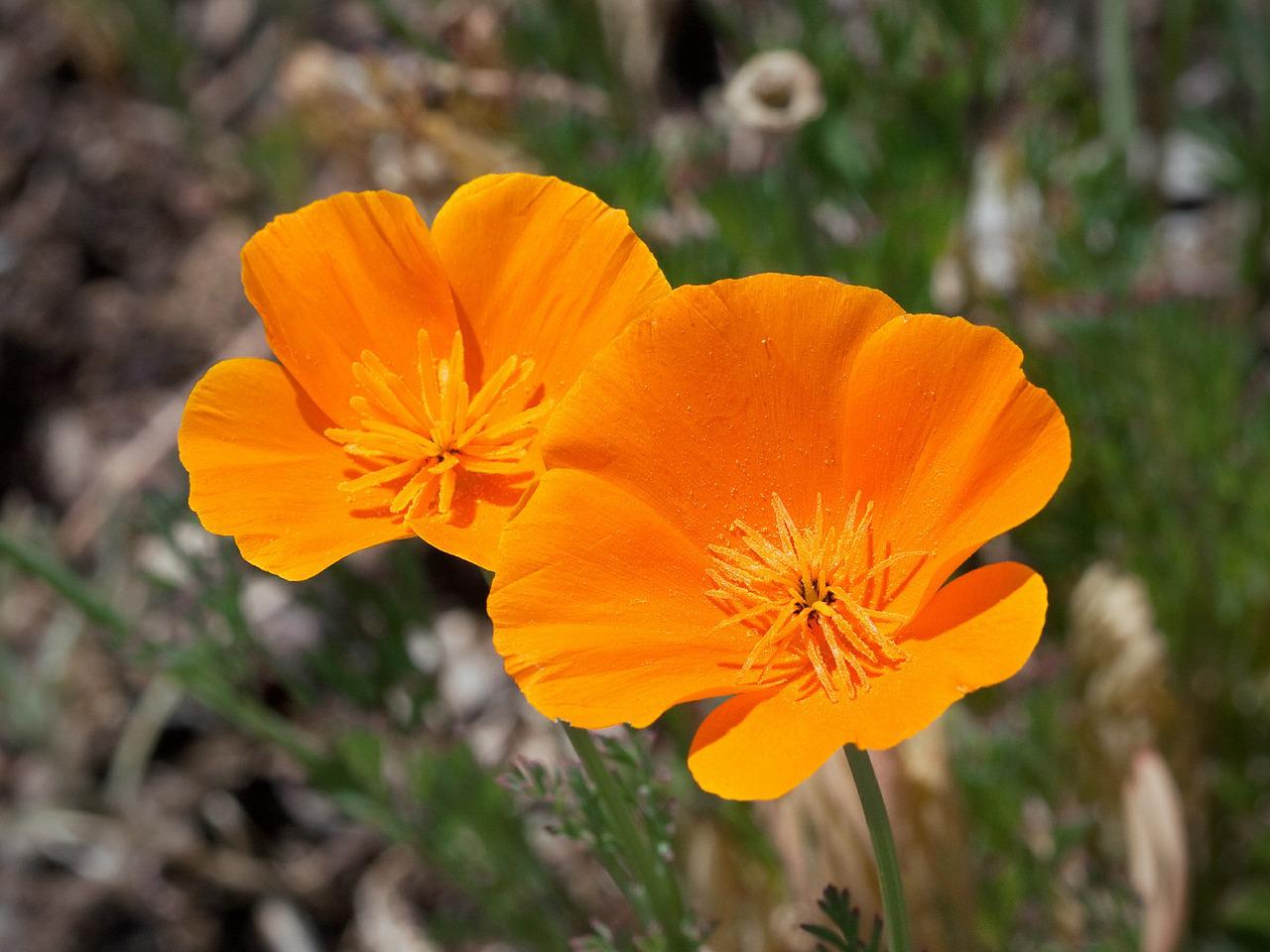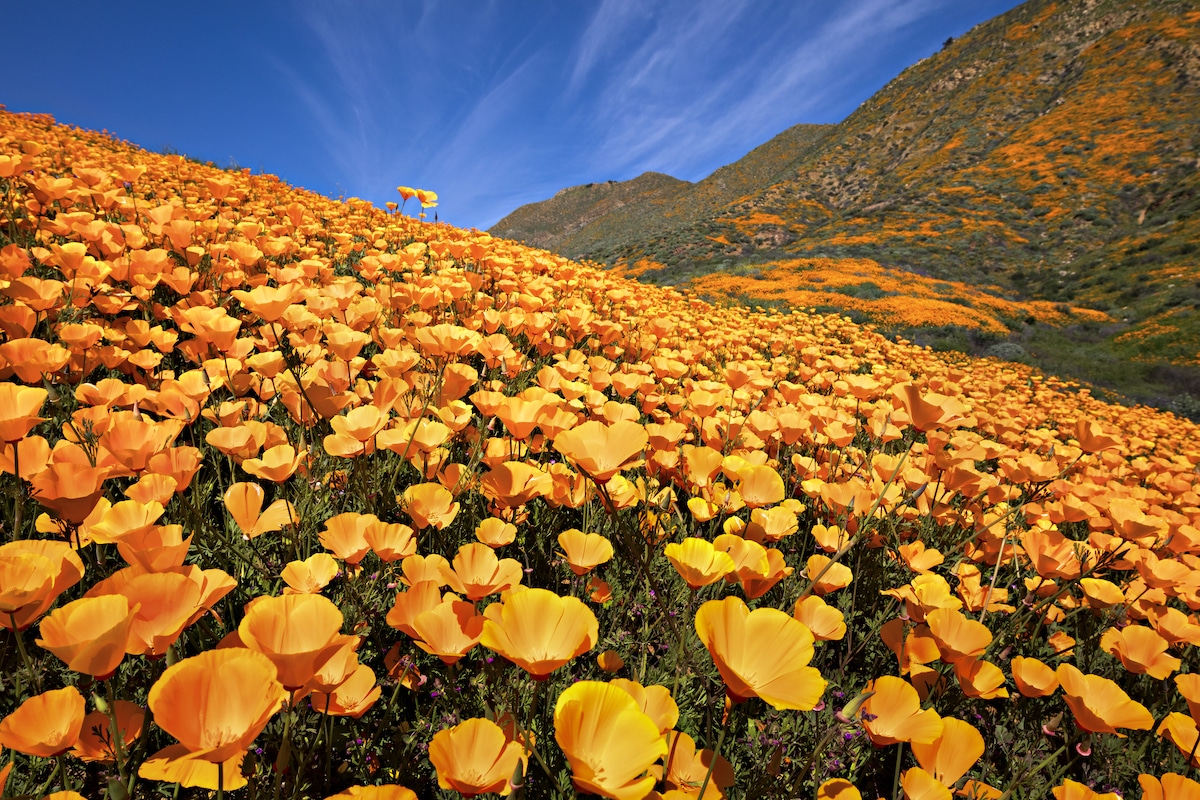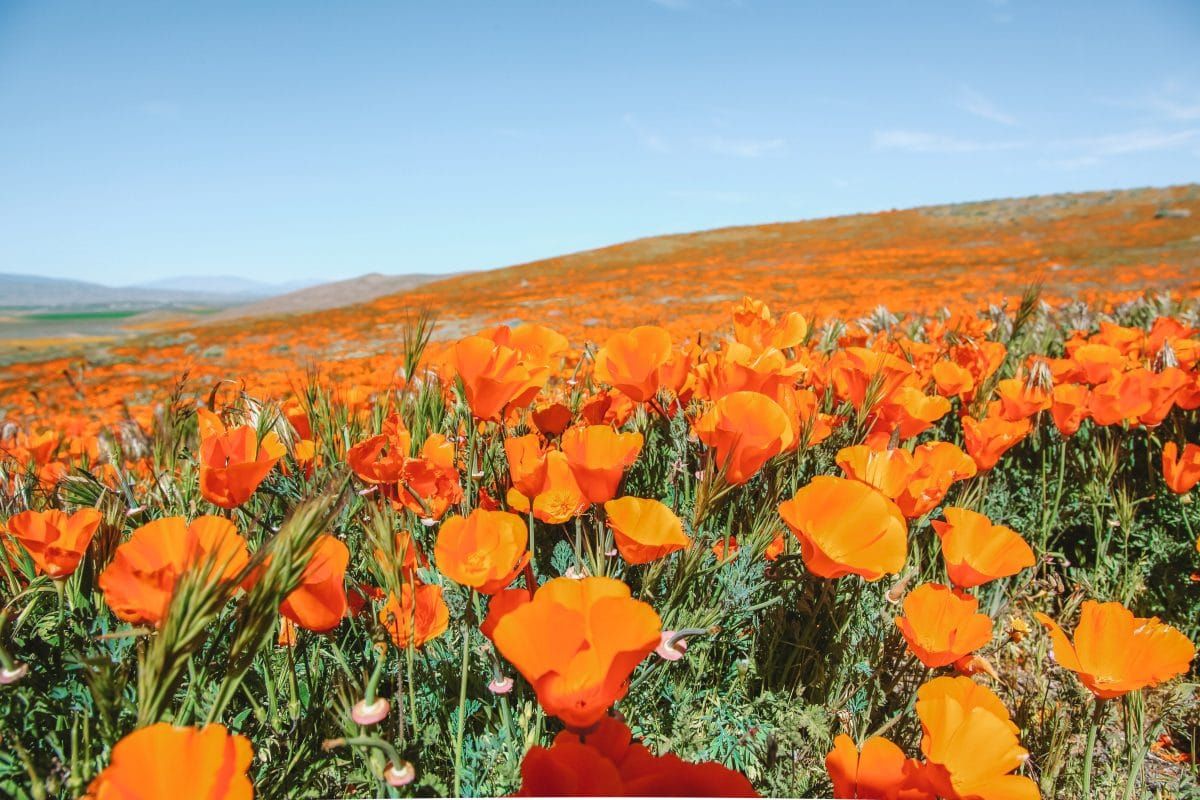Understanding the Sunlight Requirements of California Poppies
California poppies, also known as Eschscholzia californica, are a vibrant and iconic flower native to the western United States. These drought-tolerant plants thrive in well-draining soil and full sun, making them a popular choice for gardeners in warm and dry climates. But do California poppies need full sun to grow and bloom? The answer is not a simple yes or no. While California poppies can tolerate some shade, they generally require full sun to thrive.
In their natural habitat, California poppies grow in open areas with full sun, such as meadows, hillsides, and coastal bluffs. They have adapted to the intense sunlight of these environments, developing specialized leaves and stems that help them conserve water and regulate their temperature. When grown in gardens, California poppies require similar conditions to thrive. Full sun, defined as at least 6 hours of direct sunlight per day, is essential for promoting healthy growth, blooming, and seed production.
However, it’s worth noting that California poppies can tolerate some shade, especially in warmer climates where intense sunlight can be overwhelming. In these cases, providing partial shade, especially during the hottest part of the day, can help prevent scorching and promote more vigorous growth. Nevertheless, even in shadier conditions, California poppies will still require some direct sunlight to photosynthesize and bloom.
So, what happens when California poppies don’t receive enough sunlight? Without sufficient light, these plants may become leggy, weak, and prone to disease. They may also fail to produce flowers or seeds, reducing their overall reproductive success. On the other hand, providing too much sunlight can also be detrimental, especially in cooler climates where California poppies may be more sensitive to intense light.
By understanding the sunlight requirements of California poppies, gardeners can create optimal growing conditions that promote healthy growth, blooming, and seed production. Whether you’re growing California poppies in a container or in the ground, providing the right amount of sunlight is crucial for unlocking their full potential.
How to Provide the Right Amount of Sunlight for Your California Poppies
Providing the right amount of sunlight for California poppies is crucial for their growth and blooming. While these plants can tolerate some shade, they generally require full sun to thrive. But how do you determine the right amount of sunlight for your California poppies? Here are some tips to help you get it right.
First, assess the amount of direct sunlight your garden receives. California poppies need at least 6 hours of direct sunlight per day to bloom and grow well. If your garden receives less than 6 hours of direct sunlight, you may need to consider providing supplemental lighting or moving your plants to a sunnier location.
Next, choose a location that receives the right amount of sunlight for your California poppies. If you’re planting in a container, make sure it’s located in a spot that receives full sun. If you’re planting in the ground, choose a location that receives full sun for at least 6 hours a day.
It’s also important to consider the intensity of the sunlight. California poppies prefer bright, direct sunlight, but they can be sensitive to extreme heat. If you live in a hot climate, you may need to provide some shade for your plants during the hottest part of the day.
Another factor to consider is the time of day. California poppies prefer morning sun, which is gentler and less intense than afternoon sun. If possible, orient your garden to receive morning sun, which will help promote healthy growth and blooming.
Finally, be mindful of the surrounding environment. If you’re planting California poppies near trees or other plants, make sure they won’t be shaded out. Also, avoid planting in areas with reflective surfaces, such as white walls or sidewalks, which can increase the intensity of the sunlight.
By following these tips, you can provide the right amount of sunlight for your California poppies and help them thrive. Remember, the key is to provide at least 6 hours of direct sunlight per day, while also considering the intensity and timing of the sunlight.
The Benefits of Full Sun for California Poppies
Full sun is essential for California poppies to thrive, and it provides numerous benefits for these beautiful flowers. One of the most significant advantages of full sun is increased blooming. California poppies that receive at least 6 hours of direct sunlight per day produce more flowers and bloom for a longer period. This is because sunlight triggers the production of flowers and seeds, allowing the plant to reproduce and spread.
Full sun also promotes healthier foliage and improved overall growth. California poppies that receive adequate sunlight have stronger stems, larger leaves, and a more vibrant color. This is because sunlight provides the energy needed for photosynthesis, which is essential for plant growth and development.
In addition to promoting healthy growth and blooming, full sun also enhances the beauty and vibrancy of California poppies. The bright orange and yellow colors of these flowers are more intense in full sun, making them a stunning addition to any garden or landscape. Furthermore, the delicate shape and texture of the flowers are more pronounced in full sun, adding to their beauty and charm.
For example, a garden bed filled with California poppies that receive full sun will be a stunning sight to behold. The vibrant colors and delicate shapes of the flowers will create a beautiful display that will attract bees, butterflies, and other pollinators. In contrast, a garden bed with partial shade will have fewer flowers and less vibrant colors, resulting in a less impressive display.
It’s worth noting that while full sun is essential for California poppies, it’s also important to provide some shade during extreme heat. Prolonged exposure to direct sunlight can cause the leaves to become scorched and the flowers to wilt. Providing some shade during the hottest part of the day can help prevent this and keep the plants healthy and thriving.
In summary, full sun is essential for California poppies to thrive, and it provides numerous benefits for these beautiful flowers. By providing at least 6 hours of direct sunlight per day, you can promote healthy growth and blooming, enhance the beauty and vibrancy of the flowers, and create a stunning display in your garden or landscape.
Can California Poppies Tolerate Partial Shade?
While California poppies generally require full sun to thrive, they can tolerate some partial shade. However, it’s essential to understand the pros and cons of growing California poppies in partial shade and how it can affect their growth and blooming.
Partial shade can be beneficial for California poppies in hot and dry climates, where intense sunlight can cause scorching and wilting. Providing some shade during the hottest part of the day can help prevent this and keep the plants healthy and thriving. Additionally, partial shade can help retain moisture in the soil, reducing the need for frequent watering.
However, partial shade can also have some drawbacks. California poppies grown in partial shade may produce fewer flowers and have less vibrant colors. This is because sunlight is essential for photosynthesis, and reduced sunlight can limit the plant’s ability to produce energy. Additionally, partial shade can make the plants more susceptible to disease and pests, as the reduced sunlight can weaken the plant’s immune system.
It’s also worth noting that the type and duration of partial shade can affect the growth and blooming of California poppies. For example, dappled shade or morning shade may be more beneficial than full shade or afternoon shade. Additionally, the duration of partial shade can also impact the plants, with shorter periods of shade being less detrimental than longer periods.
In general, California poppies can tolerate partial shade, but it’s essential to weigh the pros and cons and consider the specific growing conditions. If you’re growing California poppies in partial shade, make sure to provide enough sunlight for the plants to thrive, and consider supplementing with artificial lighting if necessary.
Some examples of partial shade conditions that may be suitable for California poppies include:
- Dappled shade from trees or other plants
- Morning shade, with full sun in the afternoon
- East- or west-facing gardens, with partial shade during the hottest part of the day
Ultimately, the key to growing healthy and thriving California poppies in partial shade is to provide enough sunlight and to monitor the plants’ response to the shade conditions. By understanding the pros and cons of partial shade and adjusting your growing conditions accordingly, you can help your California poppies thrive and produce beautiful flowers.
How to Make the Most of Morning Sun for Your California Poppies
Morning sun is a great way to provide your California poppies with the sunlight they need to thrive. The gentle, warm light of the morning sun is perfect for promoting healthy growth and blooming. Here are some tips on how to make the most of morning sun for your California poppies:
First, orient your garden to maximize morning sunlight. If possible, plant your California poppies on the east side of your garden, where they will receive direct sunlight in the morning. This will help them get the light they need to start the day off right.
Next, consider the intensity of the morning sun. While California poppies can tolerate some shade, they generally require full sun to thrive. If you’re growing your poppies in a location that receives partial shade in the morning, you may need to supplement with artificial lighting to ensure they’re getting enough light.
Another way to make the most of morning sun is to use it to enhance blooming. California poppies are more likely to bloom in the morning, so providing them with plenty of sunlight during this time can help promote more blooms. You can also try using morning sun to stimulate blooming by providing a burst of light in the morning, followed by a period of shade in the afternoon.
Finally, don’t forget to provide some shade for your California poppies during the hottest part of the day. While morning sun is great for promoting growth and blooming, the intense sunlight of the afternoon can be too much for these delicate flowers. Providing some shade during this time can help prevent scorching and keep your poppies healthy and thriving.
Some examples of how to use morning sun to enhance the growth and blooming of California poppies include:
- Planting on the east side of your garden to receive direct morning sunlight
- Using mirrors or reflective surfaces to bounce morning sunlight onto your poppies
- Providing a burst of morning sunlight to stimulate blooming, followed by a period of shade in the afternoon
By making the most of morning sun, you can help your California poppies thrive and produce beautiful blooms. Remember to provide plenty of sunlight, but also be mindful of the intensity of the sun and provide some shade during the hottest part of the day.
Common Mistakes to Avoid When Providing Sunlight for California Poppies
When it comes to providing sunlight for California poppies, there are several common mistakes to avoid. These mistakes can lead to poor growth, reduced blooming, and even plant death. Here are some of the most common mistakes to avoid when providing sunlight for California poppies:
Providing too little sunlight is one of the most common mistakes made when growing California poppies. While these plants can tolerate some shade, they generally require full sun to thrive. Providing too little sunlight can lead to weak and spindly growth, reduced blooming, and a higher risk of disease.
Not considering the intensity of sunlight is another common mistake. California poppies can be sensitive to intense sunlight, especially in warmer climates. Providing too much sunlight can lead to scorching, wilting, and even plant death. It’s essential to consider the intensity of sunlight when providing sunlight for California poppies.
Neglecting to provide shade during extreme heat is another mistake to avoid. While California poppies require full sun to thrive, they can be sensitive to extreme heat. Providing shade during the hottest part of the day can help prevent scorching and wilting.
Not orienting the garden correctly is another mistake to avoid. California poppies require full sun to thrive, so it’s essential to orient the garden to receive direct sunlight. Planting on the east or west side of a garden can provide the necessary sunlight for California poppies.
Some examples of common mistakes to avoid when providing sunlight for California poppies include:
- Planting in a location that receives too little sunlight
- Not considering the intensity of sunlight in warmer climates
- Neglecting to provide shade during extreme heat
- Not orienting the garden correctly to receive direct sunlight
By avoiding these common mistakes, you can provide the optimal sunlight conditions for your California poppies to thrive. Remember to provide full sun, consider the intensity of sunlight, and provide shade during extreme heat.
California Poppies and Sunlight: Frequently Asked Questions
Here are some frequently asked questions about California poppies and sunlight:
Q: How much sunlight do California poppies need?
A: California poppies generally require full sun to thrive, but they can tolerate some shade. They need at least 6 hours of direct sunlight per day to produce plenty of blooms.
Q: Can California poppies grow in full shade?
A: No, California poppies cannot grow in full shade. They require some direct sunlight to produce blooms and thrive. While they can tolerate some shade, full shade can lead to weak and spindly growth, and reduced blooming.
Q: How can I provide the right amount of sunlight for my California poppies?
A: To provide the right amount of sunlight for your California poppies, assess the amount of direct sunlight your garden receives and choose a location that receives at least 6 hours of direct sunlight per day. You can also use mirrors or reflective surfaces to bounce sunlight onto your plants.
Q: Can I grow California poppies in a container?
A: Yes, you can grow California poppies in a container. Just make sure the container is at least 6-8 inches deep and has good drainage. Also, choose a location that receives at least 6 hours of direct sunlight per day.
Q: How can I protect my California poppies from extreme heat?
A: To protect your California poppies from extreme heat, provide some shade during the hottest part of the day. You can use a shade cloth or a trellis to provide shade. Also, make sure the soil is consistently moist to prevent scorching.
By answering these frequently asked questions, we hope to provide you with a better understanding of the sunlight requirements of California poppies and how to provide the optimal sunlight conditions for your plants.
Conclusion: Unlocking the Full Potential of Your California Poppies with Optimal Sunlight
In conclusion, providing optimal sunlight for California poppies is crucial for their growth and blooming. While they can tolerate some shade, they generally require full sun to thrive. By understanding the sunlight requirements of California poppies and providing the right amount of sunlight, you can unlock their full potential and enjoy their beautiful blooms.
Remember, the key to providing optimal sunlight for California poppies is to assess the amount of direct sunlight your garden receives and choose a location that receives at least 6 hours of direct sunlight per day. You can also use mirrors or reflective surfaces to bounce sunlight onto your plants and provide some shade during extreme heat.
Experimenting with different sunlight conditions can help you find what works best for your California poppies. Don’t be afraid to try new things and adjust your approach as needed. With a little patience and practice, you can create a stunning display of California poppies that will bloom beautifully and bring joy to your garden.
By following the tips and guidelines outlined in this article, you can provide the optimal sunlight conditions for your California poppies and enjoy their beauty and vibrancy. Whether you’re a seasoned gardener or just starting out, this guide will help you unlock the full potential of your California poppies and create a stunning display of color and beauty in your garden.



/california-poppy-0521bdaa-1bacc6b79b574300be11693241d0c64e.jpg)


:max_bytes(150000):strip_icc()/how-to-grow-and-care-for-california-poppies-4686987-02-6468674a60e64d55b0616c6feb5ac984.jpg)

:max_bytes(150000):strip_icc()/how-to-grow-and-care-for-california-poppies-4686987-5-b4f4a98422564a4fa4822d9d73b33a3b.jpg)